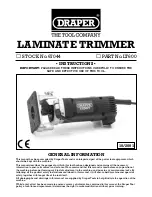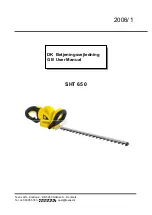
4
ENGLISH
(Original instructions)
5
ENGLISH
(Original instructions)
b. Avoid body contact with earthed or grounded
surfaces such as pipes, radiators, ranges and
refrigerators.
There is an increased risk of electric shock
if your body is earthed or grounded.
c. Do not expose power tools to rain or wet conditions.
Water entering a power tool will increase the risk of
electric shock.
d. Do not abuse the cord. Never use the cord for
carrying, pulling or unplugging the power tool. Keep
cord away from heat, oil, sharp edges or moving
parts.
Damaged or entangled cords increase the risk of
electric shock.
e. When operating a power tool outdoors, use an
extension cord suitable for outdoor use.
Use of a cord
suitable for outdoor use reduces the risk of electric shock.
f. If operating a power tool in a damp location is
unavoidable, use a residual current device (RCD)
protected supply.
Use of an RCD reduces the risk of
electric shock.
3. Personal safety
a. Stay alert, watch what you are doing and use common
sense when operating a power tool. Do not use a
power tool while you are tired or under the influence
of drugs, alcohol or medication.
A moment of inattention
while operating power tools may result in serious personal
injury.
b. Use personal protective equipment. Always wear eye
protection.
Protective equipment such as dust mask,
non-skid safety shoes, hard hat, or hearing protection
used for appropriate conditions will reduce personal
injuries.
c. Prevent unintentional starting. Ensure the switch is in
the off-position before connecting to power source
and/or battery pack, picking up or carrying the tool.
Carrying power tools with your finger on the switch or
energising power tools that have the switch on invites
accidents.
d. Remove any adjusting key or wrench before turning
the power tool on.
A wrench or a key left attached to a
rotating part of the power tool may result in personal injury.
e. Do not overreach. Keep proper footing and balance at
all times.
This enables better control of the power tool in
unexpected situations.
f. Dress properly. Do not wear loose clothing or
jewellery. Keep your hair, clothing and gloves away
from moving parts.
Loose clothes, jewellery or long hair
can be caught in moving parts.
g. If devices are provided for the connection of dust
extraction and collection facilities, ensure these are
connected and properly used.
Use of dust collection can
reduce dust-related hazards.
h. Do not let familiarity gained from frequent use of tools
allow you to become complacent and ignore tool
safety principles.
A careless action can cause severe
injury within a fraction of a second.
4. Power tool use and care
a. Do not force the power tool. Use the correct power
tool for your application.
The correct power tool will do
the job better and safer at the rate for which it was
designed.
b. Do not use the power tool if the switch does not turn it
on and off.
Any power tool that cannot be controlled with
the switch is dangerous and must be repaired.
c. Disconnect the plug from the power source and/or the
battery pack from the power tool before making any
adjustments, changing accessories, or storing power
tools.
Such preventive safety measures reduce the risk of
starting the power tool accidentally.
d. Store idle power tools out of the reach of children and
do not allow persons unfamiliar with the power tool or
these instructions to operate the power tool.
Power
tools are dangerous in the hands of untrained users.
e. Maintain power tools. Check for misalignment or
binding of moving parts, breakage of parts and any
other condition that may affect the power tools
operation. If damaged, have the power tool repaired
before use.
Many accidents are caused by poorly
maintained power tools.
f. Keep cutting tools sharp and clean.
Properly
maintained cutting tools with sharp cutting edges are less
likely to bind and are easier to control.
g. Use the power tool, accessories and tool bits etc. in
accordance with these instructions, taking into
account the working conditions and the work to be
performed.
Use of the power tool for operations different
from those intended could result in a hazardous situation.
h. Keep handles and grasping surfaces dry, clean and
free from oil and grease.
Slippery handles and grasing
surfaces do not allow for safe handling and control of the
tool in unexpected situations.
5. Battery tool use and care
a. Recharge only with the charger specified by the
manufacturer.
A charger that is suitable for one type of
battery pack may create a risk of fire when used with
another battery pack.
b. Use power tools only with specifically designated
battery packs.
Use of any other battery packs may create
a risk of injury and fire.
c. When battery pack is not in use, keep it away from
other metal objects, like paper clips, coins, keys,
nails, screws, or other small metal objects, that can
make a connection from one terminal to another.
Shorting the battery terminals together may cause burns
or a fire.
d. Under abusive conditions, liquid may be ejected from
the battery; avoid contact. If contact accidentally
occurs, flush with water. If liquid contacts eyes,
additionally seek medical help.
Liquid ejected from the
battery may cause irritation or burns.
e. Do not use a battery pack or tool that is damaged or
modified. Damaged or modified batteries may exhibit
unpredictable behaviour resulting in fire, explosion or risk
of injury.
f. Do not expose a battery pack or tool to fire or
excessive temperature.
Exposure to fire or temperature
above 130 ºC may cause explosion.
g. Follow all charging instructions and do not charge the
battery pack or tool outside the temperature range
specified in the instructions.
Charging improperly or at
temperatures outside the specified range may damage the
battery and increase the risk of fire.
6. Service
a. Have your power tool serviced by a qualified repair
person using only identical replacement parts.
This will
ensure that the safety of the power tool is maintained.
b. Never service damaged battery packs.
Service of
battery packs should only be performed by the
manufacturer or authorised service providers.
Safety instructions for hedge trimmers and pole
hedge trimmer
@
Warning!
Hedge trimmer safety warnings.
u
Keep all parts of the body away from the blade. Do not
remove cut material or hold material to be cut when
blades are moving.
Blades continue to move after the
switch is turned off. A moment of inattention while operat-
ing the hedge trimmer may result in serious personal
injury.
u
Carry the hedge trimmer by the handle with the
blade stopped and taking care not to operate any
power switch.
Proper carrying of the hedge trimmer will
decrease the risk of inadvertent starting and resultant
personal injury from the blades.
u
When transporting or storing the hedge trimmer,
always fit the blade cover.
Proper handling of the hedge
trimmer will decrease the risk of personal injury from the
blades.
u
When clearing jammed material or servicing the unit,
make sure all power switches are off and the battery
pack is removed or disconnected.
Unexpected actuation of the hedge trimmer while clear-
ing jammed material or servicing may result in serious
personal injury.
u
Hold the hedge trimmer by insulated gripping
surfaces only, because the blade may contact hidden
wiring.
Blades contacting a "live" wire may make exposed
metal parts of the hedge trimmer "live" and could give the
operator an electric shock.
u
Keep all power cords and cables away from cutting
area.
Power cords or cables may be hidden in hedges or
bushes and can be accidentally cut by the blade.
u
Do not use the hedge trimmer in bad weather condi-
tions, especially when there is a risk of lightning.
This
decreases the risk of being struck by lightning.
@
Warning!
Pole hedge trimmer safety warnings.
u
To reduce the risk of electrocution, never use the pole
hedge trimmer near any electrical power lines.
Contact
with or use near power lines may cause serious injury or
electric shock resulting in death.
u
Always use two hands when operating the pole hedge
trimmer.
Hold the extended-reach hedge trimmer with
both hands to avoid loss of control.
u
Always use head protection when operating the pole
hedge trimmer overhead.
Falling debris can result in
serious personal injury.
Safety of others
u
This tool is not intended for use by persons (including
children) with reduced physical, sensory or mental capa-
bilities, or lack of experience and knowledge, unless they
have been given supervision or instruction concerning use
of the tool by a person responsible for their safety.
u
Children should be supervised to ensure that they do not
play with the appliance.
Residual risks
Additional residual risks may arise when using the tool which
may not be included in the enclosed safety warnings. These
risks can arise from misuse, prolonged use etc.
Even with the application of the relevant safety regulations
and the implementation of safety devices, certain residual
risks can not be avoided. These include:
u
Injuries caused by touching any rotating/moving parts.
u
Injuries caused when changing any parts, blades or ac
-
cessories.
u
Injuries caused by prolonged use of a tool. When using
any tool for prolonged periods ensure you take regular
breaks.
u
Impairment of hearing.

























